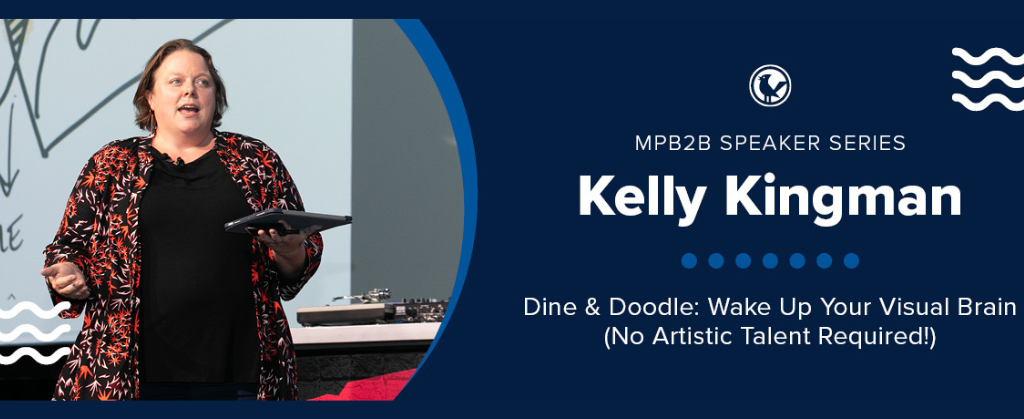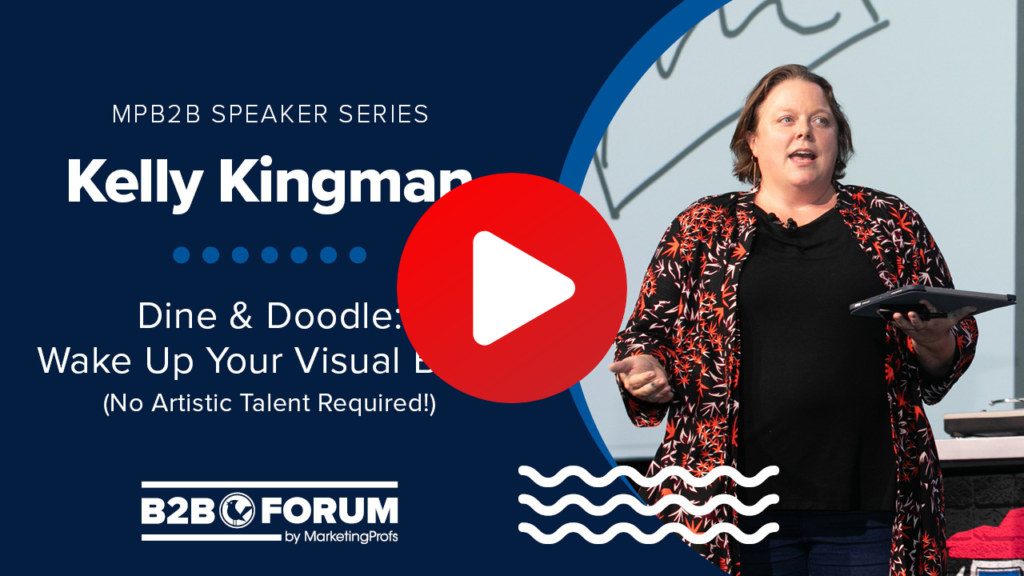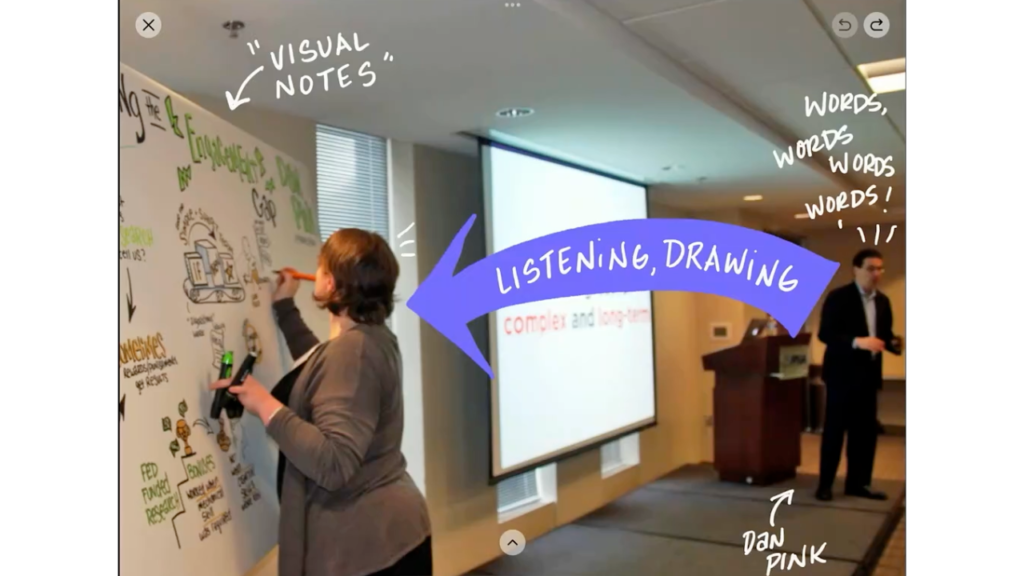
Marketing is about communicating ideas.
And while words can do that—so can images. And images can do it faster.
Plus, images can help you think through problems better and more creatively.
But what if you’re not an artist?
Kelly Kingman says you’re focused on the wrong thing.
In her Dine and Doodle session at B2B Forum 2023, Kelly revealed how easy it can be to wake up the visual side of your brain.
And you can get her lesson in the video or transcript below.
For more ways to think differently about the problems you face in marketing, join us this November for B2B Forum. With dozens of sessions on all things B2B, you’re sure to walk away with new inspiration and insights to turn your career into a masterpiece. See this year’s program now.

A lot of people, when they see what I do—which you may have seen me up here during Drew’s presentation, taking these visual notes—people often say, “you must have been an artist since forever.”
And actually… the truth is, drawing was not really my thing.

Not in school, not growing up. I never really was “drawn” to it.
But what I was drawn to was communication.
And I’ve actually, early on in my career, I found myself kind of floating back and forth between roles that were really all about words and roles that were all about images.
And I think most of us are kind of siloed in that way.
They’re sort of like, “the word people” and “the picture people.”
And I really just didn’t feel comfortable being just a word person, or just a picture person.
So I found visual notetaking and it’s perfect for me.
It’s better together.

But I think as communicators, which we all are here, we have to ask ourselves what is the most effective way to get an idea out of one brain and into another, hopefully somewhat intact.
And—spoiler alert—that is often going to involve images of some sort.
So as Anne mentioned, your cerebral cortex, the surface of your brain, 50% of that part of your brain is constantly scanning, processing, trying to make sense of all of this visual stimuli that’s coming into your retina.

And something crazy that I learned recently was that the retina is actually an outgrowth of the brain itself. It’s part of your nervous system.
And—I’m going to say a little bit more about this later—we do this at incredible speed.
So images are an incredibly efficient way to transmit information to people!
And then finally, we think differently, and I would say more creatively, when we turn ideas into something we can see. And we’re going to get a little taste of all of that today.

Today is really about reclaiming “mark making” as a tool for you to use in your own communication, but also for thinking, for your own thinking process.
AI can’t do that yet. So we’ll see.
And I call this “functional doodling” because it’s like regular doodling in that you’re just making simple marks, but it has the function of processing or sharing an idea.
That’s what today’s about.

I will like my volunteers to come up now and get situated at your flip charts. In the center of each table, we have a stack of notepads and markers. Please, everybody grab one because this is an active participation session.
I’m going to ask you to make simple marks on paper. Do not be afraid. So the next 20 minutes is really about having fun, and I really just want you to bring all the curiosity and none of the judgment. Okay? So your inner critic is really just not welcome for the next 20, 30 minutes.
And we’re going to start just with a quick warm up.
So if you could, on the page, make four or five little blobby scribbles like clusters, anything you want, four or five of these. All right?
And on the one side, on the left or right side, you’re going to draw a little skinny triangle, little skinny triangle on one side. Okay?
So that is your bird’s beak. And so if that’s the beak, then you just place an eye where the eye would go. Right next to the triangle.
And now I think birds need little birdy feet. So we got to give them little birdy feet and just do that for all of your four or five scribbles.
You can make some angry birds if you want. Or give ’em little speech bubbles.
And I think you might also want to add a little skinny triangle tail off the back.

What do we think? Does everybody have birds?
That’s just to get us warmed up.
So what I want you to take from that is a phrase I like to remember that I stole from Mike Rodie, the author and designer: “ideas, not art.”
So our brains are always making meaning and using just a couple clues to make patterns and meaning.
And so whenever I say, “draw,” whenever someone is like, maybe you want to sketch something out, just think to yourself: “ideas, not art.” Okay?
Everybody on three, say, “ideas, not art.”

“3, 2, 1, Ideas not Art!”
Awesome. All right, so that’s what we’re going to do.
I mentioned how fast our brains process visual information.
And researchers actually found that if you take a bunch of images and flash them in front of people and then ask them questions about it later, it only takes about 13 milliseconds to extract the basic meaning from a picture.
That’s 13 thousandths of a second.
Compare that to 200 milliseconds to recognize a word, and it’s kind of impressive.

So what we’re going to do next is talk about how to lower the bar when you’re sketching, because we don’t need to do much to get the basic meaning across.
Could one of you tell me, if I asked you to draw a cat, it might be a little like, “what is the cat doing?”
(Do you want to draw a cat?)
But you have to think about where it’s sitting, what it’s doing, what does the cat’s body look like?
But instead, I would ask, “what are the identifying features of a cat?” What would you say?
The ears? So we start with the ears. Would that give us a cat? Maybe we need a little nose. Do we have a cat yet? A tail. I feel like that’s a cat, right? Maybe some whiskers.
So this is what I’m talking about. This is what I call my “minimum viable cat.”

When you’re drawing, think of what are the very fewest things that you can add to make something look like the object that you want.
You want just enough detail, not too abstract, and you lose the meaning. Too realistic, and you’re just off in rendering.
Published April 24, 2024
B2B Forum is packed with marketing insights, strategies, and tactics taken from the real world experience of over forty industry experts, packaged into context you can actually put to use.
Join us in Boston for B2B Forum 2024 this coming November 12-14, 2024. Early buyers get B2B Forum tickets at their lowest rate, and discounted hotel rooms are available while they last.